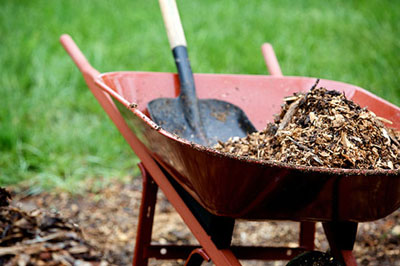There’s a nip in the air, and the leaves are fiery colors. Fall is a time for roasting marshmallows, wearing knitted hats and jumping into piles of leaves. It’s also the perfect time for putting your garden to bed for the winter. Winterizing not only makes your garden look prettier in the cold months ahead, but it also makes the work of spring planting much easier. So don’t hang up your tools just yet! It’s a joy to be outside, and there are plenty of things to keep you in your garden a little longer this year.
If you haven’t already, you definitely want to start by cleaning up all dead and decaying plant debris. Although a tidy garden is definitely something to strive for, this is not only for looks. The main reason you want to clear out dead and dying plants is because they may harbor pests and diseases that can over-winter in your soil. This spells disaster for your garden next spring!
Fall is a great time to fertilize your soil. If you have read any of my previous articles, you’ll know that I highly recommend using all-organic fertilizers. When using organic amendments, it’s beneficial to add them to the soil in the fall. Organic fertilizers are slower acting and take a few months before they can be utilized by plants. So if you add them now, you will be giving your seedlings a great start for the next growing season.
I actually prefer making my own fertilizer. It’s a little more trouble, but much less expensive than buying it pre-mixed in bags. If this sounds like something you’d be interested in, here is the recipe I use: 4 measures soybean meal, 1/2 measure agricultural lime, 1 measure hard rock phosphate, 1/2 measure kelp meal, 1/4 measure greensand and gypsum. You can find all of these ingredients at Farmer’s Co-op. What I do is scoop these items into a 5-gallon bucket and stir it up with a trowel as I go. It’s not imperative to add the greensand and gypsum, but they are great sources of trace minerals. The first four ingredients are essential, though, so I wouldn’t stray too far from the measurements. You definitely don’t want to add more than 1/2 measure of lime into the mix. Lime is important, but if you add too much, you risk severely upsetting the pH of your soil. And this can have devastating effects!
Fall is also the perfect time to add organic matter to your soil. There are all kinds of suitable products to buy, but my favorite ones are absolutely free! Fallen leaves are in abundance this time of year and I always take advantage of these. You can add leaves to the soil “as is” or better yet, rake them into short piles and run over them with a lawn mower to shred them first. This will prevent them from blowing around and it will help them break down in the soil more quickly. Coffee grounds are another wonderful addition to your soil. You need a lot of them to make a difference, though. Don’t worry, you don’t have to drink twenty pots of coffee every day! Just visit any local coffee shop and they will gladly give you a big bag of coffee grounds for free. Manure is one of the best things you can add to your garden to improve soil fertility. If you don’t have a backyard full of farm animals, don’t despair. Craigslist is a great place to find people who love to give away horse poop!
If I could only tell you only one thing to do to your garden before winter, it would be to mulch. Most people know the importance of mulching trees, bushes and perennials before winter, but few see the relevance in mulching an empty garden spot. Bare soil is not a good thing for many reasons. Exposure to the elements erodes valuable topsoil, allows weeds to flourish and degrades the structure of the soil. If you use an organic mulch, such as straw or leaves, you’ll also be enriching your soil. When soil microbes feed on the mulch, natural humic acids are released which make nutrients more readily available to plants. Mulch also helps control soil temperature which protects earthworms and other beneficial creatures living underground. I always add a thick layer of straw to my garden, but any organic mulch will do. Grass clippings, chopped leaves, pine needles and shredded bark are a few. Just make sure you rake the mulch back at least two weeks prior to planting in the spring.
These are a few of the things you can do to help the fertility and health of your garden. You can do these any time of the year but if you get these crucial chores out of the way now, you’ll be ahead of the game once the weather turns warm in the spring.














